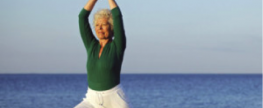
Tai Chi can enhance your second half of life in so many ways It is an ancient Chinese martial art form, and loosely translated it means “ultimate life force”. Using a series of movements that increase flexibility, build strength, and restore balance, Tai Chi helps a person reach a heightened sense of being. Many people tend to slow down, as they get older. Exercise can become more strenuous with age, taking its toll on the body. One of the many reasons Tai Chi has a big following in the mature community is because it is gentle, requiring little strain on the body. As you enter this part of life, it can help empower you by letting you connect to the strength inside of you, balancing your physical, emotional and spiritual well-being. No longer does growing older have to mean growing weaker. Doctors and other Western medicine practitioners have recommended Tai Chi for years. There are more and more studies proving the beneficial nature of its practice. We’ve listed some of the benefits Tai Chi has to offer below. Fall Prevention and Balance Building Falling is the leading cause of both fatal and nonfatal injuries. One of Tai Chi’s biggest benefits (and the one backed by the most evidence) is that it increases your balance, thus reducing the risk of falling. It strengthens leg muscles and increases flexibility in the ankles, which helps you balance on uneven surfaces. Tai Chi also builds core strength, a vital part of maintaining your balance. Connect socially What a better thing to connect over than a shared interest in an engaging, beneficial exercise such as Tai Chi. Check out your local community center or senior citizens center to find out when are where classes...



